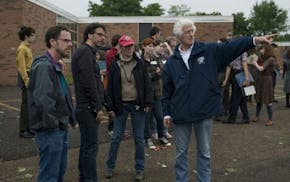Walking started as a fitness trend when ancient vertebrates first strode out of the primordial sea and onto dry land, about 400 million years ago. Which makes walking a workout even older than yoga, though possibly not water aerobics.And no wonder the sport has legs. It's the simplest, easiest and most accessible form of outdoor exercise -- or indoor, thanks to malls and skyways. It's low impact, requires no special location or equipment beyond decent shoes, and most people can do it. Its benefits, according to the Mayo Clinic, include lowered blood pressure, decreased "bad" cholesterol and increased "good" cholesterol, reduced diabetes risk, mood and cognitive improvement and, of course, the ever popular weight management.
Some people like walking but want to take it, well, a step further. Enter a couple of souped-up styles of perambulation: Nordic walking, which involves using specially designed poles; and race walking, which is walking really fast without breaking into a run. Like regular walking, both can be practiced outdoors on trails and sidewalks, or indoors in an uncrowded space. But they require more attention to form -- newcomers can benefit from brief instruction -- and, in the case of Nordic walking, a bit more equipment.
Both are particularly popular among older people. They're rigorous but not risky, don't require club or team membership, can be done either alone or in groups.
Let's get one touchy issue out of the way: To the uninitiated observer, both activities can look a little, well, strange. Nordic walkers look like they meant to go skiing but forgot their skis. Race walkers adhere to a strict form that involves churning, bent arms, short strides and a bit of a hip-swivel.
"It's not a real glamorous thing," admitted medal-holding race walker Anita Macias-Howard, 57, of Edina. "It's a funny-looking thing."
Most enthusiasts consider the occasional odd glance a small tradeoff for enjoyable activities that, they say, provide a great workout.
Nordic walking, popularized in Europe in the 1990s, is to walking as an elliptical trainer is to a treadmill -- arms move in rhythm with legs. The poles are used to push off, one side at a time, with each step. The extra effort increases the heart rate, oxygen consumption and calories burned, said Rhea Kontos, an instructor with Great Lakes Nordic Walkers. The upper body gets a toning, strengthening and range-of-motion workout that regular walking can't provide.
"With regular walking, you use 60 percent of your muscles -- with poles, 90 percent," Kontos said. "I like to say, if you pop in a stick of gum you'll have ramped it up to 100 percent, because you'll be moving your jaw."
The poles are lightweight aluminum, with straps on the handles and pointy tips that can be capped with a rubber grip, depending on the walking terrain. Good ones range in price from just under $100 to about twice that. Many collapse for easy packing.
Older people like using the poles, Kontos said, because they help with stability and balance. Several local Nordic walking groups are specifically for members age 55 and up.
Connie Lewis started Nordic walking two years ago, often accompanied by friends on trails near her home in Plymouth.
"I like the added workout that you get," said Lewis, 63. "I have more energy and my arms feel more firm."
Race walking is another way to amp up a walking workout. Macias-Howard is a one-time competitive runner who suffered a knee injury. Forced to slow down, she tried just walking fast. But she was always tempted to start running, and her knee pain would flare up again. She quit the exercise altogether, but then developed some physical problems and gained about 25 pounds.
Eventually, she heard about race walking. She taught herself to do it and lost the extra pounds. But for a while she walked solo. Then she saw a poster for a local race-walking group, Twin Cities Race Walkers, which offers training, weekly group walks and camaraderie. "I was so excited, I was practically crying," she said.
Macias-Howard demonstrated the proper technique: keep the front leg straight, and one foot touching the ground at all times. Lifting both simultaneously, in a race, is grounds for disqualification.
Twin Cities Race Walkers offers information about both casual and more competitive race-walking events. Macias-Howard has participated in the 5,000-meter race-walking competitions in the Minnesota Senior Games, placing first in her age group.
"Right now, this is a good venue for me," she said. "I really like this."
LEARNING TO WALK
RACE WALKING
Twin Cities Race Walkers (twincitiesracewalkers.org/index.html) provides monthly race walking instruction sessions, promotes local race walking events, and holds weekly informal race walking gatherings in Minneapolis and St. Paul.
NORDIC WALKING
Great Lakes Nordic Walkers (GLNW, greatlakesnordicwalkers.com) offers information about classes, events and groups (some especially for people 55 and over). Poles are available at Hoigaard's in St. Louis Park and Nordic Walk This Way (nordicwalkthisway.com). Free introductory walks led by GLNW instructors will be available at Taste of Nordic Walking, 9 to 11 a.m. July 20 at the Edina and Eagan YMCAs (open to both members and non-members).
Katy Read • 612-673-4583

This reporter didn't survive his audition for 'Survivor'
Spring's hot gift book features gorgeous found-nature photos

Jane Smiley hits again with 'Lucky' but what the what is that ending?

Biography details what 'Rulebreaker' Barbara Walters did to get to the top

